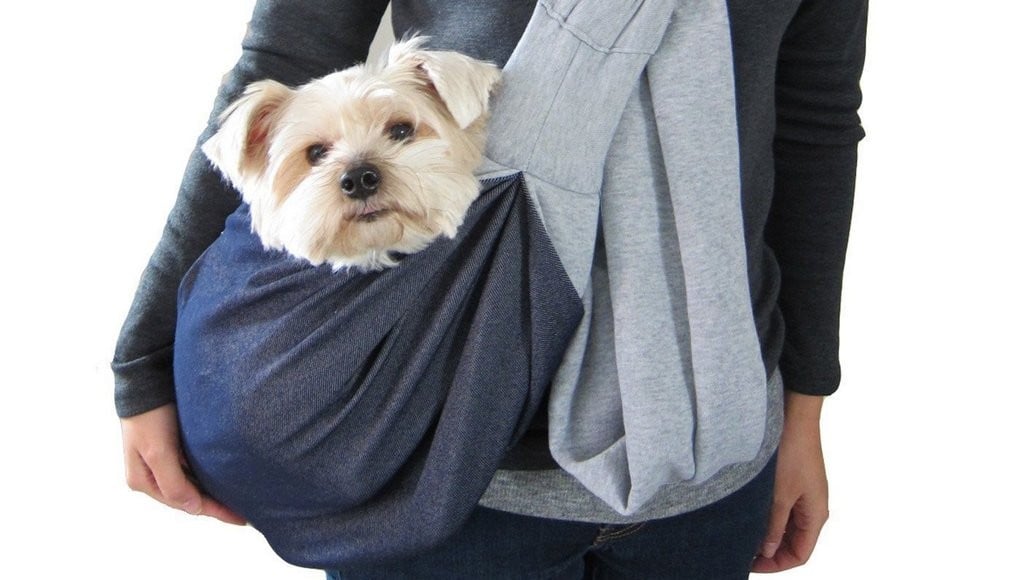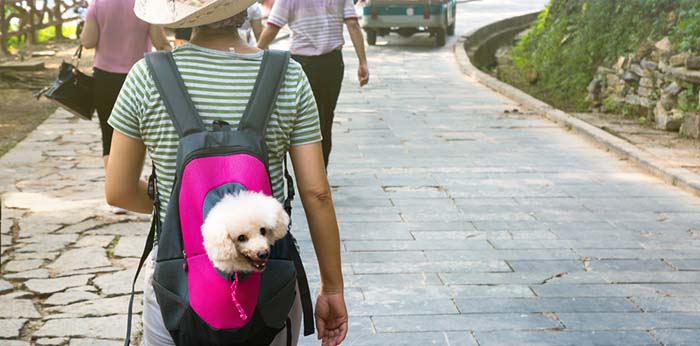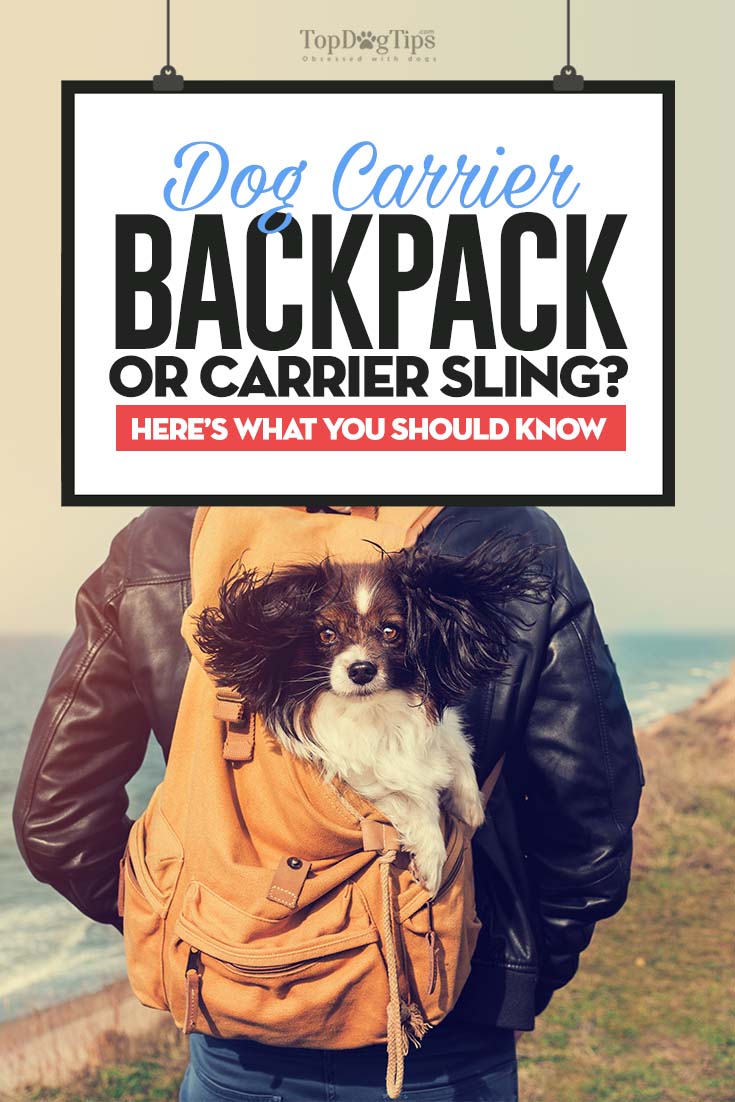Table of Contents
An easy way to tote your small breed dog around is something that every dog owner needs. Whether you're taking a trip to the vet, the park, or whatever destination you and your Fido have in mind.
But what's the best fit for you and your pet – dog carrier backpack, dog carrier sling, or something else entirely? We'll look at some of these dog supplies to see what fits you.
Backpacks and carriers for dogs are becoming very popular among pet owners.
Women, in particular, seem to make purses and handbags for dogs the new fashion trend instead of pet carriers. Some choose dog slings over a purse.
When it comes to the ergonomics of dog carriers, dog slings, and other options, bulky kennels or cages for dogs aren't the first choices.
Usually, a dog carrier backpack or a dog carrier sling is most convenient for walking about.
So let's look at which option out of these – a dog backpack or dog sling – is better for you.
EXAMPLES: The 5 Best Dog Carrier Slings
What are dog backpacks and carrier slings?
Backpack carriers for dogs and dog slings each have their pros and cons, and whether or not either is the right fit for you and your dog depends on several criteria:
- Your dog's breed (personality and size in particular)
- Where you're going to use the pet carrier
- Why do you think you need a dog carrier in the first place

No matter which pet carrier you choose, dog backpack carriers and dog slings are suitable only for miniature and toy/teacup dog breeds.
Most pet carriers, including slings and dog purses, are only rated to carry pets only between 8-15 pounds.
Like dog strollers, some pet owners often find these dog products confusing or feel odd lugging their dog in a “purse.”
Fear not, because these carriers are becoming very popular.
It's similar to mothers who use kid carriers to tote their infant babies around – it's the same idea, only for your fur babies, dogs, and cats.
It's also the primary reason for the weight limit on these dog slings and dog backpacks being so low.
Your pet is either hanging off your shoulders and back or off your side, and too much weight would be uncomfortable for you and likely damage your body.
Not to mention, a grown chocolate Lab probably wouldn't be very comfortable in a dog sling.
When you're on the lookout for the correct dog carrier backpack for you and your pet, you always have an option to shop in a local pet store. Bring your dog with you and try the dog products before you decide.
Dog Carrier Considerations
There are several things you should consider before buying any dog carrier:
- Comfort for your dog?
- Comfortability for you?
- Is the material easy to clean?
- Is the page easy to put on by yourself?
- Will the color, style, and material match your typical wardrobe?
- Is it adjustable to use for other pets, or someone else in your family could wear it too?
With the above in mind, let's look at the pros and cons of the two most popular pet carriers. The dogs carrier backpack and the dog carrier sling.
READ ALSO: The Best Backpacks and Saddle Bags for Dogs
Dog Carrier Backpack vs. Dog Carrier Sling
As I mentioned, choosing between a dog carrier backpack or a dog carrier sling is just a matter of your personal preference.
The superiority of one over the other will depend entirely on what you need to get out of your pet carrier and how you use it.
Both types of pet carriers are only suitable for small dog breeds, and they are both used for the same purpose.
Depending on your comfort and your dog's comfort, you will have to decide which dog carrier or dog sling style you like better.
Pros and Cons of Dog Carrier Backpacks
 Doggy backpacks can be very basic or come with all kinds of features. Depending on your needs and how much you are willing to spend on them.
Doggy backpacks can be very basic or come with all kinds of features. Depending on your needs and how much you are willing to spend on them.
They all work the same.
Take a look at these best dog backpack carriers to understand what's out there.
How to use a dog backpack carrier: It's all pretty self-explanatory. Place your dog inside the backpack like you would slide an infant into a baby backpack.
That means pay attention to your dog's comfort and do it slowly and carefully.
The key with dog backpack carriers is to get your dog used to them. This is so your dog wouldn't be opposed to getting into them after the first experience, which may be unpleasant.
Dog Backpack Carriers Difference From Regular Backpacks
First, to protect your canine from falling out of the backpack, there is often a leash inside that you can hook the dog's collar onto while carrying them.
Second, while some simple design backpacks for dogs are only made to contain your pet, others are of higher quality. They are equipped with dog supplies-specific storage pockets and complete enclosures with mesh netting for ventilation. And some even have built-in food and water bowls.
REVIEW: K9 Sport Sack Dog Backpack
PROS of Dog Backpack Carriers
 A significant advantage of a dog backpack carrier is that it's easy to carry, and because you will hold the weight of the animal on your back, it won't strain your arms or legs.
A significant advantage of a dog backpack carrier is that it's easy to carry, and because you will hold the weight of the animal on your back, it won't strain your arms or legs.
The dog also isn't encumbered by a crate or kennel walls, both of which can be nerve-wracking for puppies.
This way, your pup can see everything around him while also being protected.
There's a wide variety of dog backpacks available for purchase – from very fancy high-quality ones to cheap dog backpacks. Most of them come with a different set of features that will change how you use them.
For example, there are rolling backpacks you can buy that take the weight off your back whenever you need to do so (perfect for travel and flights).
Rolling dog backpacks can be converted into carrying bags for dogs by simply pushing the handle down.
You can also find backpacks that allow you to carry your pet on your front instead of your back.
Unlike a dog sling, pet backpacks often have a lot of storage pockets specifically for dog supplies so you can place all the other things your traveling dog may need on a trip — dog treats, toys, water.
And as noted above, you will often find an attachment leash inside dog backpacks that will secure your dog inside the pet carrier by his collar.
READ: 14 Safety Tips and Tricks for Hiking With Your Dog
CONS of Dog Backpack Carriers
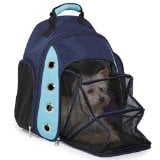 Convenience and variety aside, there are a few negative aspects to dog backpacks compared to a dog sling that you should consider before purchasing one.
Convenience and variety aside, there are a few negative aspects to dog backpacks compared to a dog sling that you should consider before purchasing one.
For example, if your dog has bone or joint issues such as arthritis or osteoporosis, the backpack may not provide adequate support for the dog.
It may be uncomfortable for your pet to sit in the backpack's position, and it could put unnecessary stress and pressure on his bones and joints.
That said, neither will a dog carrier sling. It's best to avoid any pet carriers if your dog has any joint problems or struggles with canine arthritis or hip dysplasia.
If a dog carrier backpack doesn't have a leash or harness (usually cheap ones don't), he may jump out. This won't happen with a dog sling.
To avoid your pet sneaking out of your backpack, check the brand and features that accompany the bag you're purchasing.
You want your dog to be snug and secure but not too cramped, as that could cause muscle or joint discomfort.
Compared to dog carrier slings, the main drawback of backpacks is that they are bulkier and take up more space.
You cannot fold them and hide them away, so you need to commit to carrying a dog backpack with you and deciding whether you need it.
RELATED: 10 To-Dos to Prepare for Hiking with Dogs
Key Takeaway on Dog Backpacks:
Storage pockets, dog attachment leash, and wheels (on some) are the main advantages of dog carrier backpacks over pet carrier slings.
You don't get any of these three features with a dog sling. For this reason, backpacks are usually preferred over dog carrier slings by consumers that like to travel with their small dogs.
Travel isn't the only reason to consider these backpacks, however. You can use dog carrier backpacks for your regular daily trips to the local grocery store or more rugged hiking adventures.
Remember that smaller breeds will get more tired on lengthy hikes than larger dogs, which is where these dog backpacks are beneficial.
The only drawback of backpacks compared to dog slings is that they are bulkier. Also, not all dogs may enjoy not being able to see your face when they're in the back.
Here is one dog owner's experience and outlined benefits of using a dog backpack daily. She talks about the pros and cons and how she uses her doggy backpack with the pet.
Dog Carrier Slings: Pros and Cons of

Another way to carry your dog is a dog sling, but these are not as popular as backpacks or even handbags and purses for dogs.
They're rare to see.
Most dog carrier slings are made of sturdy fabric that wraps around your pet's midsection and has handles near the top for you to carry him.
These doggy slings are typically used with older dogs or dogs recovering from an injury that needs assistance getting around.
However, they're still not the best way to carry your arthritic dog.
Even though it doesn't seem like it, most dog carrier slings are reinforced with solid material that allows your dog to be held up securely.
The sling doesn't cover your canine's limbs, but it doesn't allow him to dangle.
These types of midsection dog slings are also beneficial for dogs who need their spinal columns to remain straight or have a rib injury.
You would need to consult with a veterinarian to see whether a carrier sling will fit well your specific dog.
Most pet slings are easy to carry dogs because they have two handles, as your average grocery bag does.
They will stress a specific part of your body more, however.
Hoisting larger small dogs is no mean feat, and you need to be cleared for lifting before thinking about purchasing this type of dog carrier sling.
Another type of dog carrier sling is made of cloth that wraps across your body and allows you to situate your small dog inside the carrier in front of you, like a baby sling carrier.
These slings differ in shape and size depending on what you need them.
This cross-body doggy sling is situated from shoulder to hip and formulated using a sturdy, reinforced fabric much like the above-discussed version of the carrier sling.
RELATED: How to Measure for and Choose the Right Dog Harness (Video)
PROS of Dog Carrier Slings
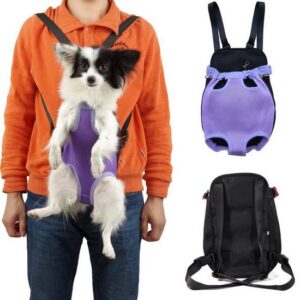
The main advantage of dog carrier slings is that they allow you to keep your arms free while carrying your Fido.
Whether you're carrying your small dog and walking your large breed on a leash, or want your hands free to talk on your cell phone, or to hold a coffee cup, a dog sling for your pet will undoubtedly help in all those respects.
Also, this type of carrier dog sling is secure enough to ensure that your dog is both comfortable and snug.
Since these doggy sling carriers rest on your side, your pet is pressed directly against your body.
That physical closeness helps many dogs feel more comfortable and fosters the bond between you and your dog during a trip.
For example, rear-facing dog backpacks can be scary for dogs that aren't used to them because they cannot see you.
With a dog sling, it hangs on your side, and your dog can stick his head out and see the owner whenever he wants.
This will give him a feeling of safety and security that your puppy may not get while riding in a doggy backpack.
READ: How to Measure a Dog for Clothing (Video Guide)
CONS of Dog Carrier Slings
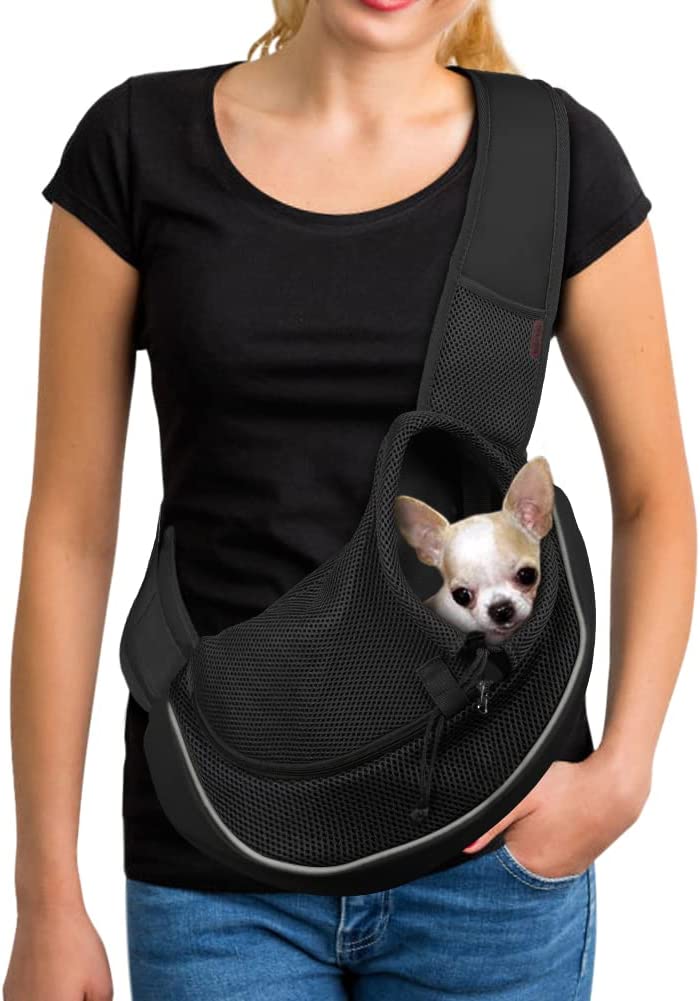
Cross-body dog carrier slings are best for the most miniature breeds of dogs or puppies only.
Usually, their carrying capacity is not expansive. Many only rates for dogs under 10 pounds, if that.
Likewise, even if your dog is under the weight limit but is longer in size, like a Dachshund, for example, they still may not have enough room in this type of pet carrier to be comfortable.
After reading many dog carrier sling reviews, I' also noticed that many pet owners made a good point that although their dogs met the weight requirements, they were still too long to fit comfortably in a cross-body sling.
This was a prevalent issue with carrier slings.
Case in point: When buying a dog carrier slings, don't go by weight alone – measure.
Another downside to these pet sling carriers is that your dog has more leeway to move around, so if you have an energetic puppy or a hyper dog, you may not want to carry them in a carrier sling to avoid trouble.
For hyper dogs, it's best to use a dog backpack that will enclose the pet entirely so there is no chance of escape, while with a sling, he will have more freedom to move around and either constantly try to escape or fidget so much that it's uncomfortable for you.
Finally, similar to a doggy backpack, older dogs with joint issues or dogs recovering from an injury would likely find these pet carriers uncomfortable and unhealthy. To tuck a dog into a sling, you would have to bend the legs, which causes discomfort.
Moreover, the gravity weighing down on their already uncomfortable bones and joints would worsen it. So avoid carrier slings for pets with these health problems.
RELATED: How to Make and Use A Rear Leg Sling for Dogs (DIY Video Guide)
Key Takeaway on Dog Sling:
The main advantage of dog carrier slings is that they may look more stylish. They also are more comfortable in some cases while not as comfortable in other ways.
Another pro of carrier slings is that most of them allow your pet to see you and look at you whenever he wants, whereas a dog backpack will keep your pup in the back, facing the back of your head and not seeing you.
There are more disadvantages of carrier slings when comparing them to dog backpacks. Slings are less sturdy, do not provide clip attachments or storage pockets, and can only host tiny dogs in size and weight (usually up to 6-10 lbs).
Dog BackPack vs. Dog Carrier Sling Final Thoughts
So which one, or dog backpack or dog carrier sling? It all depends on what you're trying to do.
The bottom line in our comparison of dog carrier slings versus dog backpack carriers is that you must put your pet's comfort first.
Measure and weigh your dog, consider how you're going to use your pet carrier, and then pick the right type.
Remember to take into account your dog's physical health condition as well.
Either a dog backpack or dog sling that's supportive around the dog's midsection is most suitable for dogs with physical mobility problems or joint pain but is still not recommended.
READ NEXT: 6 Important Tips for Long Distance Traveling with Your Dog
Disclosure: We may earn affiliate commissions at no cost to you from the links on this page. This did not affect our assessment of products. Read more here and find full disclosure here.


